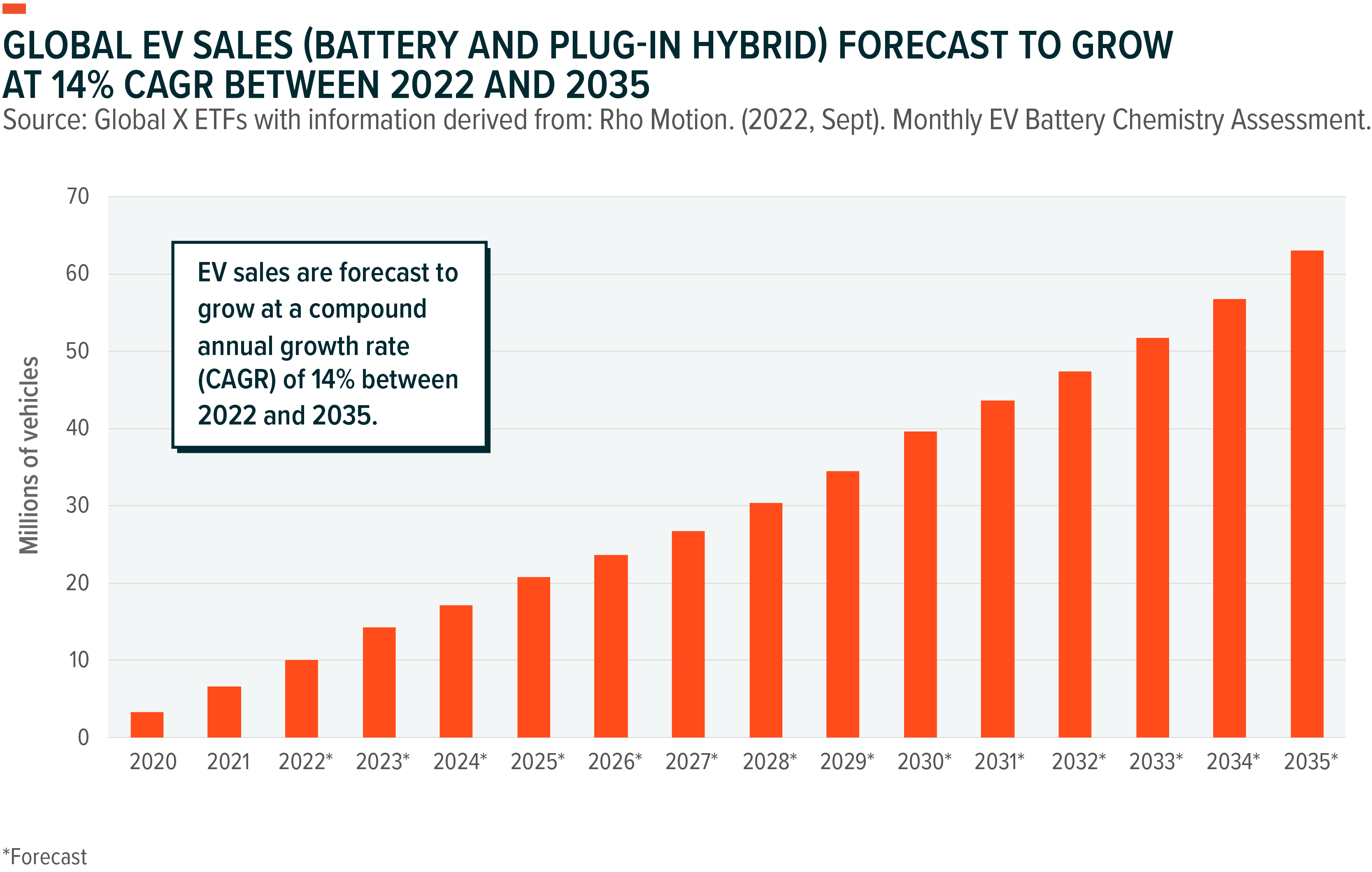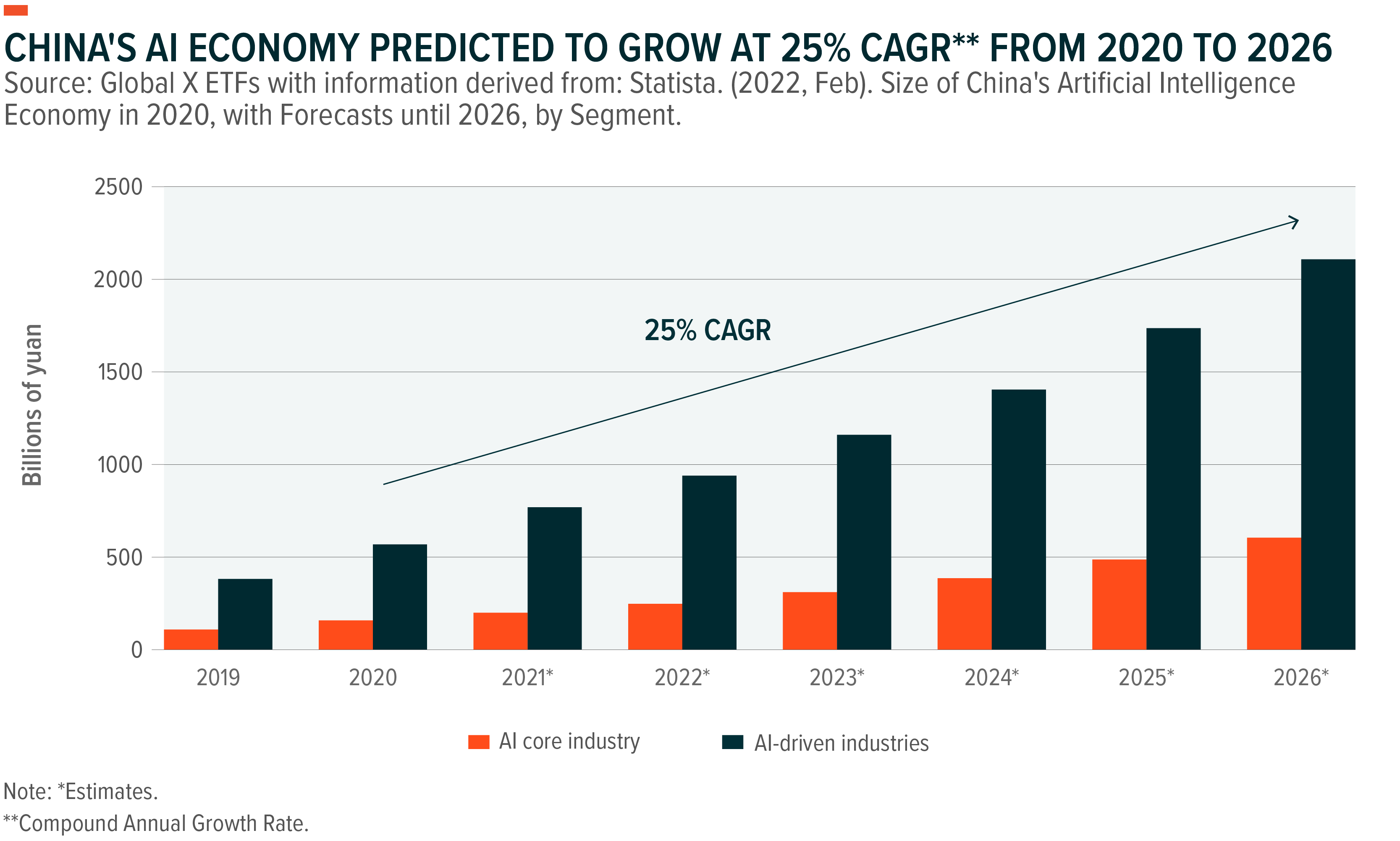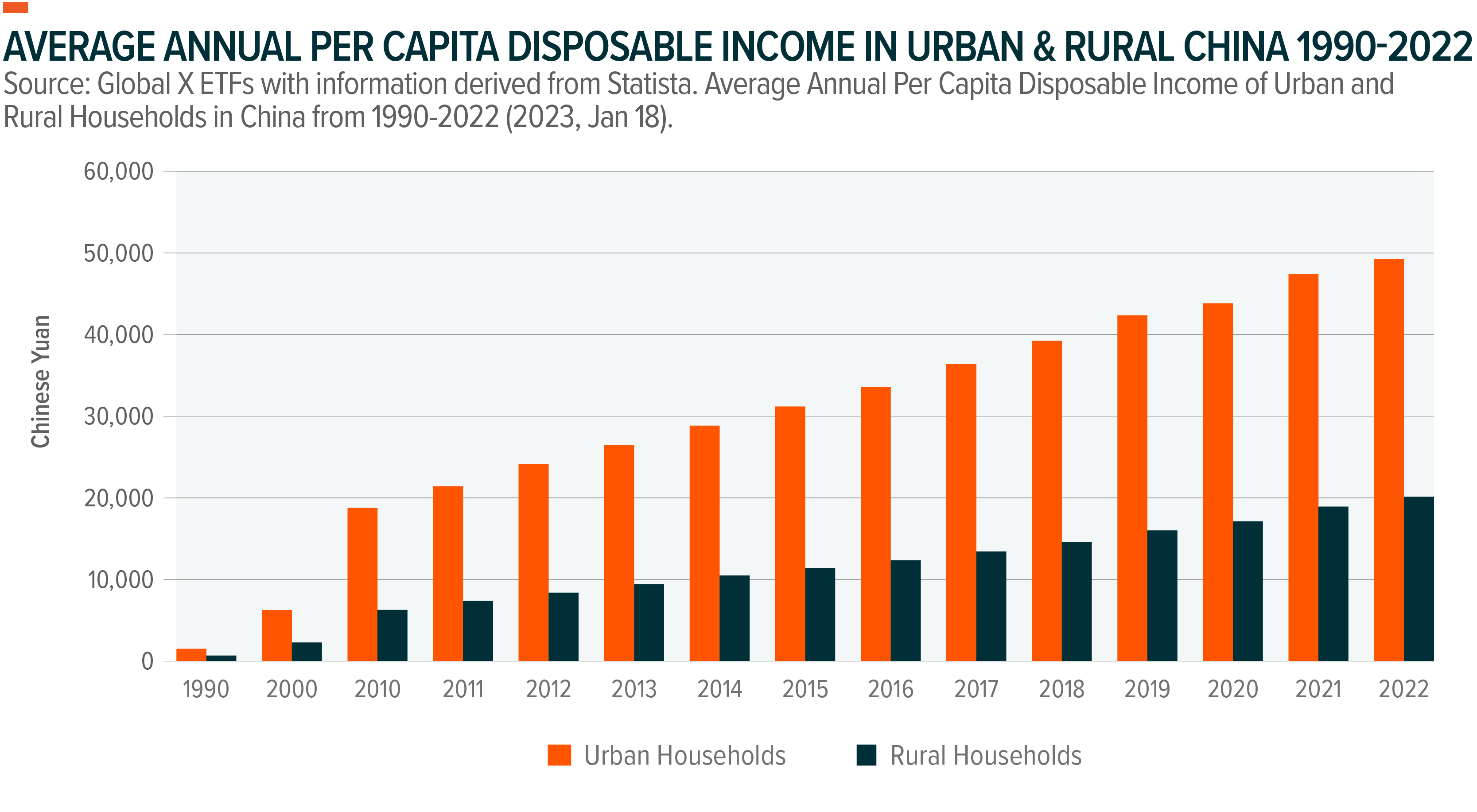Implications and Updates From China’s National People’s Conference
Earlier this year, China hosted its annual parliamentary meeting. The “Two Sessions,” as the conference is often called, revealed the country’s strategic policies in relation to its economy, trade, diplomacy, environment, and more. In the opening session, outgoing premier Li Keqiang announced a 2023 GDP growth target of “around 5%.”1 Since the reopening, China appears on track to recover its economy steadily, with most economic data points having generally improved in January with further momentum thereafter, as the feared second wave of COVID-19 did not materialize. In our view, domestic consumption will likely remain a key growth driver this year. In this article, we explore the potential implications of the Two Sessions across key investment themes in China.
Key Takeaways
- China recently hosted its annual parliamentary meeting, with likely implications for a number of key industries, including cloud computing, biotechnology, and clean energy, among others.
- With these announcements, China is looking to integrate science and technology more closely with the economy to promote productivity growth and achieve important breakthroughs, with the goal of moving faster towards self-reliance.
- Given China’s political structure, the strategic policies that emerge from the Two Sessions of the National People’s Conference (NPC) are typically very influential and bear watching by investors, in our view.
Important Changes in the Government Organization
The Central Government unveiled a restructuring plan at the NPC by establishing the National Financial Regulatory Administration and the National Data Bureau, as well as revamping the Ministry of Science and Technology.2,3,4 We regard these institutional changes as positives for investors, as the objectives are to streamline regulatory oversight in the financial sector, promote the integration and utilization of big data, and accelerate technological innovation.
We believe the reformed Ministry of Science and Technology will likely drive more dedicated and coordinated efforts in technological breakthroughs, especially in strategic tech industries like semiconductors and artificial intelligence (AI). Through the reorganization, China is probably looking to integrate science and technology more closely with the economy in order to promote productivity growth and achieve important breakthroughs, with the goal of moving faster towards self-reliance.
Implications and Updates: Electric Vehicles and Batteries
In the NPC core meeting notes, the discussion around electric vehicles (EVs) falls under the section of boosting domestic consumption. The auto industry is an important contributor to China’s consumption growth, and the manufacturing of a vehicle involves a long supply chain. Hence, strong auto demand is positive for both consumption and industrial sector development. The government will likely add charging facilities and encourage battery recycling as ways to support the EV sector.
After several phases of subsidy cuts in China, we believe the whole EV and battery theme is now less dependent on government policy incentives. Instead, electrification trends now appear more driven by the shift in strategy from corporations and consumer behavior change. As a result, we’ve seen more automotive original equipment manufacturers (OEMs) embrace electrification and redirect resources into making competitive EV models.
As we see it, the main issue on the EV theme is around competition. Tesla’s price cuts have been followed by many other Chinese OEMs. With an increasing amount of traditional automakers launching EV models, we anticipate intensified price competition in 2023. Cost-competitive car models, both EV and hybrid, are becoming an increasingly critical differentiator. This environment generally helps vertically integrated automakers such as BYD and Tesla to win market share. On the battery end, CATL is trying a new pricing strategy to win market share by sharing its profits from mining lithium with some of its strategic customers.5 We believe competition in a fast-growing theme is inevitable. The top leaders and technology innovators appear best positioned to survive a market consolidation phase and thrive immediately after. The market leaders will likely be in an even better position post consolidation, potentially enabling them to increase their bargaining power.
Implications and Updates: Clean Energy
According to the NPC working paper, clean energy will be one of the key beneficiaries of “green development.”6 There, the Chinese Government emphasized the need to strengthen the construction of urban and rural environmental infrastructure, implement important ecosystem protections, and repair major projects; promote clean coal utilization and technology development; endorse green development policies; and promote energy conservation. This will likely be favorable to renewables and renewables-related infrastructure investment growth in 2023. Undoubtedly, clean energy will be one of the key tools to realize China’s stated long-term carbon neutrality ambitions.
Sector wise, the polysilicon shortage was the apparent bottleneck in the solar value chain over the last two years. We witnessed a short and sharp fall in polysilicon prices around the new year holidays from the peak of 300 renminbi (RMB)/kg to as low as RMB120/kg, despite a very small number of orders applied.7 Our channel checks showed an accumulation of inventory, implying that a downward trend in polysilicon prices is likely going forward. We believe a shortage will no longer exist across the solar value chain through 2023. As a result, solar panel prices may settle around levels widely accepted by the downstream, with a reasonable profit distribution amongst each segment.
We are bullish about global solar demand in 2023, as polysilicon prices are stepping down. This could be particularly pronounced in the second half of the year, when new supply is expected to come out. Additionally, falling manufacturing costs could potentially drive up demand for solar farm installations in China. Supportive polices for clean energy introduced by the Biden Administration could also help make 2023 a recovery year for the US market.
For wind, the new order growth from China wind projects has remained very compelling in recent months, thanks to solid project economics.8 The moderation of raw material inflation has likely helped to improve the margin outlook of wind component suppliers and enhanced the profitability of companies in the supply chain. Despite the strong new orders, the pace of actual installations has been slower than expected, partly due to the disruption of lockdowns in December and January. However, there is now growing interest in the space, as logistics and installation disruptions seem to be behind us. We believe the strong new order growth in 2022 will finally translate to actual installations in 2023.
Implications and Updates: Cloud Computing
China’s digital economy totaled 45.5 trillion renminbi (RMB) in 2021, accounting for 40% of GDP.9 This was up from RMB22.6 trillion in 2016, representing a 15% compound annual growth rate (CAGR).10
The State Council issued its plan for a “Digital China” (the Plan) to achieve major progress by 2025 and material digitalization by 2035.11 The Plan calls for China to 1) accelerate the construction of digital infrastructure (e.g., 5G, gigabyte fiber, IPv6 implementation, Internet of Things, and BeiDou Satellite system) and improve the layout of computing power such as data centers, and 2) circulate the digital resource cycle by building country-level data management mechanisms, better utilize data resources, and unleash the value of commercial data.12
We expect that the Chinese Government’s rising focus on building a digital economy will provide a positive policy environment for internet, software, and telecommunication services companies. The Plan could accelerate demand for cloud computing resources, benefiting public and private cloud computing service providers. Moreover, increasing the exchange of data resources amongst industry participants will likely lead to rising requirements for cybersecurity, potentially resulting in increasing cybersecurity spending. According to IDC, China’s cybersecurity spending could record a CAGR of approximately 21% between 2021 and 2026, much higher than the 9% growth expected globally.13,14 Lastly, we expect software localization demand to recover in 2023, driven by the aforementioned national strategy and more government procurement.
Implications and Updates: Biotechnology
While no specific biotech-related measures were announced during the Two Sessions, the lack of any discussion on central procurement is probably a positive, as it appears that aggressive price cuts for drugs could be behind us.
The new 2022 National Reimbursement Drug List (NDRL) was officially launched and took effect on March 1, 2023. The new NDRL includes 2,967 drugs: 1,586 western drugs and 1,381 finished traditional Chinese medicines (TCM).15 There are 111 new entrants with an average price cut of 60%.16
For the CRO (Contract Research Organizations) / CDMO (Contract Development and Manufacturing Companies) sub-sector, excluding COVID-19 projects, we expect revenue growth rates to potentially range between 20-30% for most companies. For large companies, we expect core business volume growth to bounce back to 10-15% as normalization kicks in.
Implications and Updates: Semiconductors and Hardware
China will likely restructure its science and technology ministry to channel more resources to achieving important breakthroughs, with the goal of moving faster towards self-reliance.17 The proposed restructuring of the Ministry of Science and Technology (MoST) appears to signal more targeted efforts in supporting tech and innovation, as well as a top-down approach to organizing nationwide research and development (R&D) resources.18
The direction appears in line with the focus of industrial upgrades from the Government Work Report and a continuation from the 14th Five-Year Plan, which listed multiple strategic areas such as AI, quantum computing, semiconductors, and other technologies that are expected to enjoy policy support.19 Other functions of the old MoST, such as overseeing technology advancement for agriculture, will be consolidated into other ministries. The proposal also upgrades the National Intellectual Property Administration to a State Council department, indicating stronger protection of intellectual property, an essential institutional element for innovation.20
In 2023, with the further recovery of the semiconductor industry supply and demand dynamics, some subsectors, such as chip design and foundries, could bottom out and usher in recovery in the second half of the year. Over the medium and longer term, localization and structural demand from high-performance computing (HPC) and new energy applications will likely remain key drivers for the domestic semiconductor industry.

Implications and Updates: Consumer
As expected, no specific consumption-related policies were announced at the NPC this year, and we did not expect any large stimulus packages to be announced during the meeting. The government seems to be relying on domestic consumption recovery to offset weaker exports and drive economic growth in 2023. We expect a job market recovery, stabilized property market, a recovery of consumer confidence, income growth, and the release of excess savings to drive private consumption growth throughout the year.

China Manufacturing Purchasing Managers’ Index (PMI) data was strong in the first quarter, with the index in expansion territory (above 50) before pulling back in April.21 Mobility in China has already improved beyond pre-Covid levels, reflecting further normalization in business activity and travel. In addition, property markets have shown signs of stabilization.22 We believe the overall recovery trend remains on track and expect a stronger recovery from the second quarter onwards, which could reinvigorate the market’s confidence in the consumption growth outlook in China. Overall, we believe private consumption will be the major growth driver of China’s economic growth, benefiting Chinese consumer companies in 2023.
Conclusion
Given China’s political structure, the strategic policies that emerge from the Two Sessions of the NPC are very influential and bear watching by investors, in our view. The annual meeting also relates directly to a number of macroeconomic themes in the Global X ETFs China suite. Moreover, the sectors discussed above are some of the country’s largest and most important growth drivers, especially as China moves away from its “old” drivers of commodities and low-cost manufacturing toward services and higher value-add industries.



